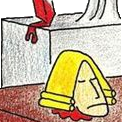Tuvell v. IBM ⸻ Story │ Record │ Discussion
[A] long line of cases shows that it is not merely of some importance, but is of fundamental importance, that justice should not only “be” done, but should manifestly and undoubtedly “be seen to be” done.
— Lord Hewart CJ,† R v. Sussex Justices, Ex Parte McCarthy, Nov 9 1923 (1 KB 256 [1923], All ER Rep 233 [1924], emphasis added), the “mother” of all “ex parte remand” cases; attributed as the genesis of the aphorism/principle that the mere appearance/perception (not necessarily actuality/reality/evidence/proof) of bias is sufficient to overturn a judicial decision (and hence, by extension, manifest appearance of lack-of-bias‡ is often cited as the prime requisite for all legitimate judicial functions, and ethics, such as a basis for judicial recusal/disqualification, etc.). {†・English case citations look foreign to American eyes. “CJ” denotes Chief Justice; “R” here stands for “Rex/Regina,” i.e., King/Queen/Crown/State/Government; “All ER” is for All England Reports; “KB” is the King’s Bench division, or “QB” when a queen is on the throne. See the Duke Research Guide to English Law ⌥. From the American perspective, see Richmond Newspapers, Inc. v. Virginia, 448 U.S. 555 (1980) ⌥ (Chief Justice Burger at ℘564–575). Oakes, Davies, Justice Must Be Seen To Be Done ⌥.} {‡・See Judicial Oath and Ethics. This judicial-ethics standard, “appearance of bias” (a.k.a. “impartiality might reasonably be questioned,” Canon 3(C)(1)), even carries the force/weight of statutory law: “Any justice, judge, or magistrate judge of the United States shall disqualify himself in any proceeding in which his impartiality might reasonably be questioned” — 28 USC §455(a). See also 28 USC §144.}

Scholium (Lesson)
This Case Study, Tuvell v. IBM, is our main/centerpiece example. It teaches, provably, the following hard lesson:
Federal Judges (as opposed to any other class of persons) can do anything they want, no matter how illicit/illegal/criminal (at all levels: District, Appellate, Supreme Court, Judicial Council, Judicial Conference). In particular, they can blithely/arbitrarily/whimsically (“conclusorily,” i.e., without any explanation whatsoever, rational or not) ignore any/all Rules/Laws/Statutes of Legal Precedence, Evidence, Facts, Obstruction of Justice, Cover-Up, and Conspiracy — with impunity, without fear of reprisal. For, nobody in any other branch of government (legislative branch of elected officials, or executive branch involving DOJ, FBI, PIN, OPR, EOUSA, Inspectors General), and nobody in the private sector (especially those learned in law: lawyers, law professors, social philosophers, ethicists, authors, journalists, etc., including self-professed “NGO whistleblowing watchdog organizations”), will “blow the whistle” on Judges — because they all Fear Speaking Truth To Power. And, the Public Forum (such as “social media”) won’t do anything either, because of general ignorance of the law and/or apathy (“it probably won’t happen to me”).
Underlying Case-In-Chief
NOTE — Some readers (esp. those interested only in judicial misconduct) may wish to skip this introductory section upon a first reading — because, knowledge of the underlying factual (substantive merits) background is completely unnecessary for understanding the judicial misconduct aspects of the case (procedural rules, which is where the judicial misconduct happened)!
► The following summary of the Tuvell v. IBM case-in-chief factual background is excerpted from the (i) Petition for Writ of Certiorari (PetWritCert) ℘7–13 ⌥ (page-footnotes appearing there are converted into paragraph-footnotes here, numbered/notated differently, as appropriate for web publication). A detailed statement of the facts of the case can be found in (ii) Plaintiff’s Complaint = Appeal Joint Appendix (AplJApx) ʋI ℘10–40 (original/verified version ⌥, “first amended” version ⌥ [they differ only in ¶102, which was inadvertently erroneously included]), and in (iii) Plaintiff’s Statement of Facts (PSOF) = PetWritCert Required Appendix (ReqApx) ℘48–84 ⌥ (also at PetWritCert Optional Appendix (OptApx) ℘172–199 ⌥); augmented by the (iv) PSOF-Exclusion Table (1-page abridged ⌥ and 5-page unabridged ⌥ versions). The evidence supporting the PSOF can be found in the (v) Appeal Joint Appendix (AplJApx) (in four parts: ʋI, ʋIIa, ʋIIb, ʋIII). Of abiding interest (for both contemporaniety and emotional impact) are the (vi) original internal complaint documents (parts of which are repeated elsewhere in the record, too) that Tuvell submitted to IBM prior to initiation of formal litigation, IbmComplaints.zip (these are voluminous and complete, as Tuvell created them to fully apprise IBM of events, and as a form of Narrative/Writing Exposure Therapy (N/WET) ⌥ to cope/manage/heal his PTSD). Finally, a (vii) time-orienting calendar has been supplied. ◄
Walter Tuvell is a white male U.S. citizen, a mathematician (B.S. MIT, PhD U. Chicago), over 40 years of age (the ADEA limit), spending his working life as a computer scientist (technical software professional). He was working at Netezza Corp. ⌥ (Marlboro, Mass.) when it was acquired by IBM on January 1 2011.α Tuvell’s job title was Performance Architect, under the organizational supervision of Dan Feldman, but reporting on a day-to-day operating basis (“dotted-line,” “matrix model”) to another supervisor, Fritz Knabe, at a satellite office (in Cambridge, Mass.), working on a next-generation database-warehouse project, code-named “Wahoo.”β
α・ All dates in this section refer to 2011, unless expressly stated otherwise.
β・ Projects at pre-IBM Netezza were customarily code-named after species of fish.
Tuvell had no history of friction with anyone at Netezza/IBM, when “out-of-the-blue” on May 18, Knabe “informed” Feldman privately that Tuvell had failed to deliver certain Excel graphics that Knabe had instructed/ordered Tuvell to produce. That was a whole-cloth lie: Knabe never broached anything like any such task to Tuvell, at any time, ever. It would have been “impossible” for Knabe to do so — since Knabe knew well that Tuvell didn’t use Microsoft software of any kind (such as Windows and Excel). Tuvell instead used exclusively the Linux “operating system,” and its “open-source” software applications; this was quite well-known (and acknowledged/accepted/permitted/encouraged) by everyone Tuvell worked with. Feldman confronted Tuvell with Knabe’s accusation later that same day, “siding” with Knabe — even though Feldman also knew well that Tuvell used only Linux-based tools.γ
γ・ For “(pretext-based) proof” of Knabe/Feldman’s dishonesty concerning the Excel graphics episode, see PetWritCert ℘30ƒ44 — noting, however, that such proof is not necessary at summary judgment stage. Instead, the judge must reflexively/automatically (with no more than de minimus plausibility of proof) credit/believe Tuvell’s side of story (“nonmovant-trumps-movant” and “light-burden” tenets of the Summary Judgment Tenets of Review (SJTOR), see PetWritCert ℘17–20, also Introduction).
Instantly, Tuvell suffered severe shock/dismay/devastation, and worse. For, Tuvell was/is a long-term victim of whistleblowing/bullying-instigated PTSD, stemming from previous defamatory/abusive workplace incidents he’d experienced more than a decade previously while at another employer, but which was since in remission (“passive”/“dormant” phase). Knabe/Feldman’s accusation immediately caused/“triggered” Tuvell to reexperience an acute/“active” PTSD “flashback”/relapse. From that moment, Tuvell struggled mightily under the resurgence of his PTSD. Tuvell hid his anguish from Feldman as best he could that day, but he did firmly deny Knabe’s charge. The next day, Tuvell proposed a three-way meeting, so that the three men could “clear the air” (determine what had really happened — potentially/hopefully just a miscommunication), and avoid its happening again.
Tuvell’s (∼half-dozen) requests for three-way meeting went unheeded,δ prompting Tuvell to explicitly reveal his PTSD affliction to Feldman on May 26, citing it as the reason he sought the three-way meeting “reasonable accommodation.”ε At that exact point, IBM was aware of Tuvell’s ADA-protected disability. Feldman nonetheless continued to deny all requests for three-way-meeting (or to suggest any other means of accommodation), causing continued decline in Tuvell’s psychological state.
δ・ The desired meeting never did materialize.
ε・ Tuvell did not use the language “ADA” or “reasonable accommodation” until later, noting that the ADA does not require the use of such “magic words” at any time. EEOC Guidance: Reasonable Accommodation (excerpted extensively at Petition Addendum (PetAdd) ℘6–9 = ReqApx ℘106–109).
On June 8, Knabe attacked Tuvell with another whole-cloth lie — this time, about Tuvell’s not timely completing a certain task, even though Knabe knew (thanks to daily “stand-up” meetings) that Tuvell was on-schedule (there was no “untimeliness”) with all his deliverablesζ — by falsely yelling loudly at Tuvell in the presence of other Wahoo team-members in Cambridge.
ζ・ (i) Tuvell had completed his task due that day. (ii) The task Knabe yelled about wasn’t due for another ten days (and Tuvell did deliver it two days later, more than a week early).
Knabe (falsely) “informed” Feldman, and on June 10 Feldman peremptorily demotedη Tuvell to a much less desirable position — “switching” him with another employee, less-qualified and lower-ranked — giving for “reason” that Tuvell and Knabe could not work together (but not holding Knabe accountable for his then-known-false actions). Tuvell protested, and immediately informed Feldman that he intended to escalate the matter to HR (Human Resources), which he did do later that same day.
η・ IBM prefers euphemistic language such as “transfer/reassignment;” but we rather agree with J. Alito’s candid characterization: “demotion” (PetWritCert ℘35).
And that’s when things really “went south.”θ
θ・ Regarding the “shortcomings” of IBM HR, consult: (i) original IBM internal complaints; (ii) Expert Report = AplJApx Exh.115–116 ⌥; (iii) Nov 17 2011, phone call (audio, transcript) with HR head Russell Mandel.
When Tuvell met with the HR representative, Kelliann McCabe, on June 13, she asked him why he thought Knabe and Feldman would act the way they did. Tuvell said he didn’t know why, but based on the fact that Feldman/Knabe displayed no interest whatever in resolving the situation (“stonewalling” even the simple/obvious proposal for three-way meeting), Tuvell surmised that “something illegal must be at the root of things,”ι and that he suspected age discriminationκ might be the motivating factor. That discrimination complaint was protected by law, of course.λ
ι・ This is a very well-known legitimate/protected pretext-based inference. The general idea, enshrined in long-standing principles of human psychology and rules of legal evidence, is simply: “if someone is lying, they’re probably hiding something bad (a.k.a. ‘pretext’ for bad/illegal behavior).” In the specific context of employment law, the most full-bodied endorsement of this idea occurs in Reeves v. Sanderson Plumbing ⌥ ⌥ (emphasis added, internal citations and quotation marks omitted): “The factfinder’s [jury’s] disbelief of the reasons put forward by the defendant [employer] (particularly if disbelief is accompanied by a suspicion of mendacity) may, together with the elements of the prima facie case, suffice to show intentional discrimination. Thus, rejection of the defendant’s proffered reasons will permit the trier of fact to infer the ultimate fact of intentional discrimination. … Proof that the defendant’s explanation is unworthy of credence is simply one form of circumstantial evidence that is probative of intentional discrimination, and it may be quite persuasive. … In appropriate circumstances, the trier of fact can reasonably infer from the falsity of the explanation that the employer is dissembling to cover up a discriminatory purpose. Such an inference is consistent with the general principle of evidence law that the factfinder is entitled to consider a party’s dishonesty about a material fact as affirmative evidence of guilt. … Moreover, once the employer’s justification has been eliminated, discrimination may well be the most likely alternative explanation, especially since the employer is in the best position to put forth the actual reason for its decision. … [W]hen all legitimate reasons for rejecting an applicant have been eliminated as possible reasons for the employer’s actions, it is more likely than not the employer, who we generally assume acts with some reason, based his decision on an impermissible consideration. Thus, a plaintiff’s prima facie case, combined with sufficient evidence to find that the employer’s asserted justification is false, may permit the trier of fact to conclude that the employer unlawfully discriminated.” In brief: “pretext-only” suffices, “pretext-plus” isn’t required; see PetWritCert ℘33ƒ51.
κ・ During the course of events as they emerged (as related in this section, and later), plaintiff was unable to uncover solid/direct evidence of age-based discrimination (making that charge “legally insufficient,” which is why (the only reason) that charge was later dropped).† On the other hand, very obvious retaliation (for complaining of discrimination in the first place)‡ did arise immediately, soon followed by a plentiful abundance of direct PTSD-disability-based discrimination and retaliation, which is what now forms the heart of the case. {†・Plaintiff could only find “hearsay“/indirect evidence of age-based discrimination, namely, “stories” of other employees’ complaints of age-discrimination, both throughout the high-tech/development community as a whole, and at IBM in particular. This has been (and still is) “well-known forever.” But this kind of information is “legally insufficient” to sustain a charge at litigation. On the other hand, a new era of investigation into the matter of IBM age (and other) discrimination, may now (at the time of this writing) be in the offing, given recent major investigative studies/publications, by such folks as (i) Sperino & Thomas (Introduction ⌥; Podcast ⌥; Review ⌥), and (ii) ProPublica, Mother Jones, IEEE Spectrum, EEOC, et al.} {‡・ A charge of retaliation remains viable even in the absence of underlying substantive discrimination (see PetWritCert ℘11ƒ17, and PetAdd ℘6 = ReqApx ℘106) — provided the retaliated-upon discrimination charge was made on reasonable grounds (as it was, because Tuvell was the oldest technical employee at Netezza, to his knowledge), and in good faith (as it was, namely pretext-based inference, see PetWritCert ℘8ƒ10, ℘10ƒ15, ℘30ƒ44, ℘33ƒ51).}
λ・ EEOC Compliance Manual §8-II(B)(2) ℘8-4–8-5 (excerpted extensively at PetAdd ℘5–6 = ReqApx ℘105–106), emphasis added: “Complaining to anyone about alleged [it does not have to be proven, to judge or jury] discrimination against oneself or others … constitute[s] [protected] ‘opposition’.”
It would take us too far afield at this point (the factual details being unnecessary for this Petition [and this Judicial Misconduct website]) to even list here the dozens of “bad things” that happened to Tuvell from that point forward.μ Suffice it to say that at every juncture, Tuvell took the right/appropriate/approved steps to “clear his name,” according to IBM’s published policies/programs/procedures/practices. This especially involved invoking IBM’s formal internal dispute resolution (IDR) mechanism, called Open Door Concerns & Appeals (C&A) [Corporate, i.e., addressed directly to the CEO and Executive Staff] — as encouraged/exhorted/commanded to do by the IBM Business Conduct Guidelines (BCG) — for which he produced valuable/detailed/voluminous reports to aid IBM’s investigation. Nonetheless, he was treated to an unrelenting stream of discriminatory/retaliatory acts, from every IBM representative/agent who “touched” his case. Whatever was the original motivating animus for the Excel graphics and yelling episodes, the resulting upshot was that after Tuvell revealed his PTSD and complained of discrimination/retaliation, the environment devolved into a steady torrent of abusive harassment.
μ・ For a rough/summary grasp of events (with only tagline names, sans explanation) see the PSOF-Exclusion Table (Abridged PetWritCert ℘29 ⌥; Unabridged ReqApx ℘86–90 ⌥).
IBM continued to refuse ADA “interactive dialogue/process” and “reasonable accommodation.” On August 15, unable to endure more health-wise, Tuvell took short-term disability (STD) leave. The one-and-only condition Tuvell required for resuming his job was cessation of PTSD-exacerbating psychological abuse, i.e., removal from Feldman’s health-harming hostile management. Absent rehabilitation/removal/transfer of Feldman, Tuvell twice applied for transfer to a known open/funded position for which he qualified; IBM officially recognizes/supports that solution, and the ADA even requires it.ν
ν・ EEOC Guidance: Reasonable Accommodation, at Reassignment (excerpted extensively at PetAdd ℘8 = ReqApx ℘108), emphasis added: “Reassignment[/transfer] is the [only] reasonable accommodation of last resort and is required ...”
But IBM refused transfer, “stonewalling” to the bitter end. Unable to return to IBM because of IBM’s refusal to accommodate his PTSD, Tuvell was forced by economic necessity to find stop-gap employment at another software company (Imprivata, beginning on March 12 2012), thinking it would be a “temporary gig” until IBM finally “wised up” and “did the right thing,” returning him to his desired job (or alternatively approving the transfer he sought) at IBM. They never did; Tuvell never returned from his STD leave. On May 17 2012, IBM terminated Tuvell on an absurd and “trumped-up” (and illegal)ξ charge.
ξ・ Discussed at PetAdd ℘19–20 = ReqApx ℘119–120.
(And that’s the Truth.)
District Court Proceedings
As recorded in the District Court Docket = AplJApx ℘1–9 ⌥ (also at OptApx ℘566–574), Tuvell v. IBM (D.Mass. case №1:13-cv-11292-DJC) ⌥ was filed in the D.Mass. District Court (First Federal Circuit) on May 30 2013 (the Complaint ⌥ has already been mentioned supra). The case had at that point been through the “usual” preliminary steps (for employment discrimination/harassment/retaliation cases): (i) submitted/charged to the MCAD (Massachusetts Commission Against Discrimination, the state’s FEPA, Fair Employment Practices Agency, affiliated wth the Federal EEOC, Equal Employment Opportunity Commission; from which it was (ii) preemptively aborted by Tuvell (before any investigation/mediation/decision); so he could (iii) request the necessary Notice of Right to Sue Letter; in order to instead (iv) promptly file suit at Mass. State Court; from which it was then (v) removed by IBM (28 USC §1441,1446) to Federal District Court.

The case was assigned to (Article III) Judge Denise Casper (having been preliminarily assigned to a Magistrate Judge, objected to by IBM; FRCP 72). http://www.mad.uscourts.gov/boston/casper.htm; https://en.wikipedia.org/wiki/Denise_J._Casper.

After a relatively uneventful (for the purposes of judicial misconduct) process of motions/discovery/depositions/affidavits/etc. (see the aforementioned 4-part AplJApx (ʋI, ʋIIa, ʋIIb, ʋIII) for much of it), IBM filed a Motion for Summary Judgment on Dec 15 2014 (Dkt#73). Hence, pursuant to customary practice in D.Mass (FRCP LR 56.1),ο the parties properly filed the following seven key documentsπ — noting that only two of them, DSOF = OptApx ℘74–91 ⌥ and PSOF = OptApx ℘172–199 ⌥ (also at ReqApx ℘48–84 ⌥), are actually required per FRCP LR 56.1. As listed at PetWritCert ℘20–21, the seven documents are:ρ
ο・ In fact, the various districts of the First Circuit (D.Mass, D.Me., D.N.H., D.R.I., D.P.R.) can/do employ different (syntactically and semantically) LR-versions of FRCP 56. So, the blanket language “First Circuit district courts” at PetWritCert ℘20 was to that extent inaccurate,† though all excerpts and reasoning were accurate for D.Mass., which is the only district involved in Tuvell v. IBM. {†・Trivial “typos” like this are of no consequence to legal proceedings: de minimis non curat lex (“the law does not concern itself with trifles”); FRCP 61.}
π・ There were also some other, non-“key,” filings, such as Defendant’s Affadivit in Support (Dkt#76) with Exhibits (Dkt#76-∗), of no consequence here.
ρ・ Legend: “✭” = required to be filed; “✔” = explicitly noted/listed/cited by the court(s); “✓” = otherwise (non-explicitly) noted by the court(s); “❎” = “X’d-out” = ignored by the court(s); “strikethrough” = “memoranda of law” (not forwarded to appeals court, because effectively replaced/superseded by ApltBrief = OptApx ℘270–341 ⌥, ApleBrief = OptApx ℘342–412 ⌥.
| The Seven Key Documents At Summary Judgment | ||
|---|---|---|
| Req | Noted | Name & Description |
| ✭ | ✔ | DSOF — Def’s Statement of Facts = OptApx ℘74–91 (Dkt#74) ⌥. |
| ✓ | ||
| ✭ | ❎ | PSOF — Plf’s Statement of Facts in Material Dispute = OptApx ℘172–199 (Dkt#83) ⌥ (also, with additional markup, at ReqApx ℘48–84 ⌥). THE COMBINATION “✭❎” HERE (REQUIRED-BUT-IGNORED “PSOF-EXCLUSION”) IS THE GENESIS OF THE “SMOKING GUN” CITED INFRA. |
| ✓ | ||
| ✔ | RespDSOF — Plf’s Response to DSOF = OptApx ℘118–170 (Dkt#82) ⌥. | |
| ❎ | RespPSOF — Def’s Response to PSOF = OptApx ℘238–268 (Dkt#87) ⌥. | |
| ❎ | ||
Oral argument = AplApx ℘212–231 ⌥ was held on Mar 12 2015. It was unilluminating, except for being remarkably brief/superficial/perfunctory (“as-if” the judge had already made up her mind, and was no longer interested in the case at this point).
The District Court’s Opinion/Decision (and Order) = OptApx ℘6–32 (Dkt#94) ⌥ (also at ReqApx ℘4–38 ⌥) was dated/delivered Jul 6 2015, filed on Jul 7, and its Judgment = OptApx ℘38 (Dkt#95) ⌥ (also at ReqApx ℘44–45 ⌥) dated/filed on Jul 8 — falsely granting IBM’s Motion for Summary Judgment and dismissing the case.
THIS IS PRECISELY WHERE THE JUDICIAL MISCONDUCT ORIGINATED (recurring/covered-up many times, as related infra): In arriving at her (false, bad-faith) decision/opinion on the Summary Judgment motion, the District Judge (falsely, in-bad-faith) refused to “hear” any part of plaintiff’s side of the case at all — by WHOLLY IGNORING/EXCLUDING plaintiff’s REQUIRED PSOF (Dkt#83), as marked “✭❎” supra, and paying attention ONLY to defendant’s DSOF (Dkt#74) — recalling that the court is ABSOLUTELY NON-DISCRETIONALLY REQUIRED to do the exact 180° opposite: consider and credit PSOF (Dkt#83) over DSOF (Dkt#74) FOR THE PURPOSES OF SUMMARY JUDGMENT (by RULE/LAW: the “NONMOVANT-TRUMPS-MOVANT” tenet of the SJTOR). Indeed, Judge Casper herself explicitly/expressly admitted/vouchsafed such, by authoring/signing the following impossibly self-contradictory “SMOKING GUN” passage (i.e., single/discrete/standalone piece of irrefutable evidence sufficient to support charges of wrongdoing) in her Decision/Opinion ℘2 (annotated here):

This (mis)behavior (which may be languaged as “treating the Plaintiff/Nonmovant as INVISIBLE”) constitutes/proves obvious/blatant/egregious/outrageous criminal/impeachable Judicial Misconduct — Falsification of Court Facts/Record, Obstruction of Justice, Fraud Upon the Court (by a Judge) [and, later, Cover-Up by this and other judges, see infra] — pure and simple. QED.
A “fraud on the court” [a.k.a. “fraud upon the court,” FUTC] occurs where it can be demonstrated, clearly and convincingly, that a party [or an officer of the court, especially a judge] has sentiently set in motion some unconscionable scheme calculated to interfere with the judicial system’s ability impartially to adjudicate a matter by improperly influencing the [judge/]trier or unfairly hampering the presentation of [a] party’s claim or defense [such as falsification of facts, as in our case].
— Aoude v. Mobil Oil, 892 F.2d 1115 (1st Cir., 1989) ⌥; see also Aoude v. Mobil Oil, 862 F.2d 890 (1st Cir., 1988) ⌥
Tuvell, a long-term victim of whistleblowing/bullying-instigated PTSD, was of course more-than-devastated by this insane/deviant decision/opinion. After weeks of “identity-crisis”-inducing internal/mental conflict (with months/years more yet to come), Tuvell’s mind was able to reconcile the court’s crazy-making behavior in only one way: “The judge must have delegated/relegated the case to an inexperienced law clerk, who was massively unqualified, and this nonsensical result will certainly be corrected by wiser heads upon appeal.”
District Court Reconsideration (Not)
Motions for reconsideration (of rulings such as a Summary Judgment dismissal) by the District Court are available (however designated, noting that the exact word “reconsideration” itself does not appear in the FRCP; FRCP 52,59,60). But these are optional/discretionary (on the Plaintiff’s part), rare, disfavored (viewed as an affront to the judge, inducing “fear of speaking truth to power” in attorneys), unlikely to succeed, disindicated in this case (the usual criteria for success didn’t apply, according to Tuvell’s counsel), expensive, and discouraged by Tuvell’s counsel — who instead advised the classic/normal/standard/usual path of “appeal as of right” (FRAP 4) to the First Circuit Court of Appeals.
Notice of Appeal = AplJApx ℘210–211 (Dkt#98) ⌥ was timely filed on Aug 5 2015.
Circuit Appellate Court Proceedings
The relevant documents filed for appellate proceedings for case Tuvell v. IBM (First Circuit case №15-1914) — apart from the district court record (esp. the seven key Summary Judgment documents), and the 4-part AplJApx (ʋI, ʋIIa, ʋIIb, ʋIII) — were:
- ApltBrief — Plaintiff/Appellant’s Brief = OptApx ℘270–341 ⌥ (effectively replacing/superseding
PMemo). - ApleBrief — Defendant/Appellee’s Brief = OptApx ℘342–412 ⌥ (effectively replacing/superseding
DMemo,RepPMemo). - RepApleBrief — Plaintiff/Appellant’s Reply to ApleBrief = OptApx ℘414–444 ⌥.
Tuvell’s ApltBrief ⌥ and RepApleBrief ⌥ were limited to a re-hash (with no more than trivial tweaks) of the arguments already made at district level (as was IBM’s ApleBrief ⌥). Most notably, they contain no mention whatsoever of the aforementioned Smoking Gun (or any other procedural aspect of the case). Tuvell objected vigorously to his attorneys about this omission, but they forcefully guaranteed him that this was the only appropriate legal practice to pursue. For (they said), an appellate court’s standard of review for a summary judgment motion is de novo (also known as plenary), and the so-called “raise-or-waive/forfeit rule” (see, e.g., Spektor & Zuckerman, Raise or Waive/Forfeit) does not apply to de novo reviews (the de novo review doesn’t cause anything, raised or not, from the court below to be later waived/forfeited; and this is especially true of pure questions of law, detached from any factual development, as is the case here) — because, the de novo review amounts to a “do-over” of the original/lower/trial court proceeding itself (anything, even things not raised at lower court, can be raised at de novo review, and furthermore anything occurring at either lower or de novo court can still be raised later). The de novo appellate court considers all party submissions/arguments, together with the “record below” (in the lower court), freshly, with a totally open mind, owing no deference whatever to the lower court’s “findings-of-fact” or “conclusions-of-law” (noting, though, that at summary judgment stage, no findings-of-fact are actually made by judges — they merely note the existence of disputed genuine issues of material fact; see Introduction). Therefore (so the attorneys said), it was not appropriate to “complain about the district court’s opinion” at initial appeal time, because the battle to be fought at that point was still against the opposing party (IBM), not against the judge(s) (that would come only later, at Petition for Appellate Court Rehearing time, per custom/usage, see infra). And anyway (so the attorneys said), the appellate panel would immediately see the district judge’s self-admission (“Smoking Gun,” supra, crediting movant over nonmovant) right before their very eyes, and hence would immediately overturn the dismissal for that simple obvious reason, so there was no need to “beat that horse any deader.”
The appellate panel consisted of judges Juan Torruella (http://www.ca1.uscourts.gov/juan-r-torruella; https://en.wikipedia.org/wiki/Juan_R._Torruella), Sandra Lynch (http://www.ca1.uscourts.gov/sandra-l-lynch; https://en.wikipedia.org/wiki/Sandra_Lynch), and Rogeriee Thompson (http://www.ca1.uscourts.gov/o-rogeriee-thompson; https://en.wikipedia.org/wiki/Ojetta_Rogeriee_Thompson) — the first two having earlier served as chief circuit judge (so things now looked hopeful for Tuvell).



Oral hearing (audio, annotated transcript) was held on Apr 5 2016. It was a remarkably confused affair: the panel obviously hadn’t done their de novo homework, and didn’t have a grasp of the case at all (neither the fundamental case-in-chief substantive aspects, nor the plain-as-day Smoking Gun procedural blunder).
The Appellate Panel’s (“summary,” Per Curiam, unanimous, not-for-publication) Decision/Opinion = OptApx ℘0–4 ⌥ (also at ReqApx ℘0–3 ⌥), and Judgment = OptApx ℘36 ⌥ (also at ReqApx ℘42–43 ⌥), were dated/delivered May 13 2016 — falsely affirming the District Court’s Decision/Opinion.
The panel’s decision/opinion affirmatively stated that it independently (plenary, de novo) drew/adopted the same/exact conclusion that the district judge did (internal citations omitted):
[APPELLATE SMOKING GUN] ☛KEY☚ Under the plenary standard of review for summary judgment, we perceive no genuine issue of material factσ and agree with the district court that IBM is entitled to judgment as a matter of law. Simply said, the district court got it right. It closely considered each of Tuvell’s arguments and, in clear terms and for persuasive reasons, rejected them.τ
σ・ This catchphrase (and its variations), “we perceive no genuine issue of material fact,” without explication, is a dead give-away: it’s the very formulaic incantation used by federal judges when they illicitly/illegally “deep-six” cases at summary judgment, especially employment discrimination cases — as admitted by a sitting federal judge (PetWritCert ℘15ƒ21).
τ・ This is shamelessly false/insane. The district judge self-admittedly did not “consider”/“hear” any of Tuvell’s asserted facts/disputes at all‼ Rather, she self-confessed, in the Smoking Gun, to practicing/committing PSOF-Exclusion. Further, at summary judgment time, it is not within any judge’s (neither district judge, nor appellate panel upon de novo review) purview to “consider and reject” (i.e., “assess/evaluate/‘weigh’ credibility to decide ‘who wins’”) disputes. Instead, the judges are required/permitted only to observe/notice the existence of disputed facts. But these judges refused to even “consider/hear” Tuvell’s asserted facts/disputes, much less whether they conflicted with IBM’s asserted facts/disputes. That is insane.
Since this is an absurd, transparent, bald-faced “big lie” — despite self-proclaimed in-depth de novo review, no less (and of course, such a de novo review must itself observe the SJTOR precepts) — the writing was now indelibly on the wall: this was now a full-blown cover-up of Judicial Misconduct, and these judges were truly bad apples, committed to flushing this case down the toilet, come hell or high water, in full-frontal defiance of professionalism, law, logic, morality, and humanity.
The gloves were now off. The war was now on.
Appellate Court Rehearing
In the run-up to rehearing, Tuvell and his attorneys came to an impasse. Tuvell’s attorneys still adamantly refused to mention procedural irregularities or the Smoking Gun at all. Tuvell now adamantly insisted upon it. No middle ground could be reached. So Tuvell and his attorneys parted ways. From this point on, Tuvell proceeded pro se (he was the sole actor involved in all subsequent activities and filings) (PetWritCert ℘viƒ6).
Petition for Rehearing (PetReh) = OptApx ℘446–470 ⌥ (also corrected version), both panel and en banc, with Annotations/Endnotes (PetRehAnn) = OptApx ℘472–484 ⌥ broken out separately because of word-count limitations (also corrected version), was filed on Jun 4 2016. In this document, Tuvell did indeed mention procedural irregularities and the Smoking Gun, for at rehearing time this was now acceptable, and even expected/required (as mentioned at PetReh ℘vƒ‡). But the Smoking Gun was mentioned in only in the mildest of circumspect terms (e.g., PetReh ℘v), to avoid offending the judges with over-the-top language.
Given the sordid history of the case to that point, it was not at all unexpected when the First Circuit Petition for Rehearing was summarily/blindly/brainlessly issued a single-sentence false denial (OptApx ℘34 ⌥; also at ReqApx ℘40–41 ⌥), on Jun 15 2016. Nor was it at all surprising that two additional judges (noting that the First Circuit is by far the smallest circuit, comprising a too-collegial/in-bred totality of only six full-time Article III judges) joined the panel of three in issuing the denial: Chief Judge Jeffery Howard (http://www.ca1.uscourts.gov/jeffrey-r-howard; https://en.wikipedia.org/wiki/Jeffrey_R._Howard), and Judge William Kayatta (http://www.ca1.uscourts.gov/william-j-kayatta-jr; https://en.wikipedia.org/wiki/William_J._Kayatta_Jr.).
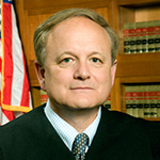

At that point in time, Tuvell was aware of only a single further avenue to pursue for redress: (i) the Supreme Court, via a Petition for Writ of Certiorari. Late during that work, he became aware of a second possible direction: (ii) Judicial Misconduct proceedings, via (ii′) Judicial Council, and (ii″) Judicial Conference. Later still, Tuvell finally became aware of a third plausible path: (iii) criminal proceedings, via DOJ/FBI/PIN/OPR/EOUSA/CIGIE. All these pursuits will be described next.
Supreme Court Proceedings
Surely, those brilliant luminary leading lights of American jurisprudence, the Justices of the United States Supreme Court, couldn’t possibly be cornswaggled — co-conspirators in the rogue First Circuit’s big lie. Right?
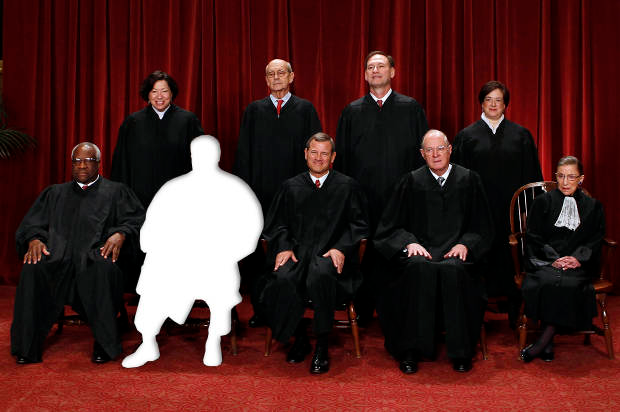
Petition for Writ of Certiorari (PetWritCert) ☛KEY☚, with Required Appendix (ReqApx), Supreme Court case №16-343, was filed on Sep 12 2016.
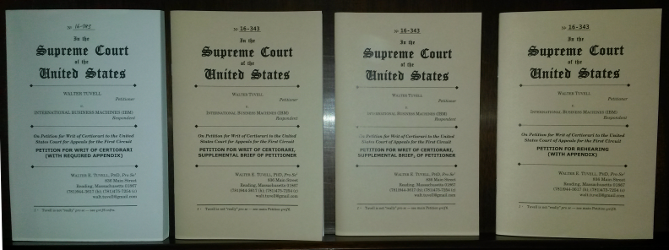
At this point in the saga, it was no longer necessary/appropriate/desirable to feign nicety towards the First Circuit judges (as had been circumspectly done in the last filing to the Appeals Court). It was still imperative to “play nice” with the Supreme Court itself, of course. But “not too nice.” All available advice (such as https://m.mayerbrown.com/Files/Publication/34891e80-a15d-4b25-84a2-d3c8573d23da/Presentation/PublicationAttachment/5f64270f-6be0-4cec-8cc8-10e6bed6988b/ART_CIRCUITRIDER_JUN07.PDF ⌥, and https://www.citizen.org/documents/GettingYourFootintheDoor.pdf ⌥) teaches that the very first substantive page (called “Question Presented”) is the most important single element of a “certworthy” Petition. That one nutshell page must make an immediate, hard-hitting impact (otherwise the Petition risks foundering from first-page ennui, filtered out by “cert pool” law clerks), designed to make the Petition an irresistibly compelling self-page-turning mystery novel. Hence (noting that more than a single Question Presented is universally regarded as “too much” for the Supreme Court to handle — “all the wood behind one arrowhead”), Tuvell’s case-in-chief had to be relegated/demoted to a PetWritCert Addendum (PetAdd) = ReqApx ℘92–123, to be revisited if/as/when the District Court’s decision/opinion was overturned. The result was:
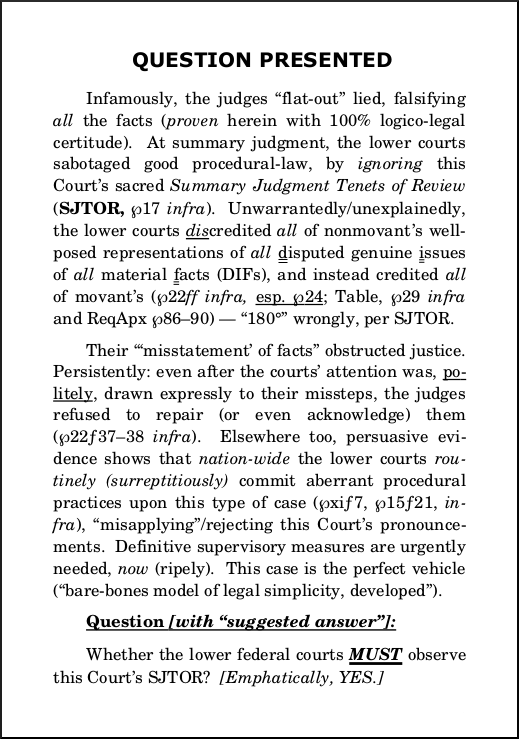
The entirety of PetWritCert is no less candid/unsparing. Ticklers touched all the Supreme Court’s sweet spots (“erogenous zones”):
- Broad reach of national scope; transcending short-sighted “trivial” exigencies of single/instant case; long-view important universal policy/doctrine matters. (Preface; PetWritCert ℘37–38.)
- Procedural (summary judgment SJTOR, as opposed to substantive case-in-chief) issues (noting the top five cited Supreme Court cases have been of the procedural due process ilk, namely, ⅚ of the two “trilogies” mentioned in the Introduction, with the remaining ⅙ ranked at #8); PSOF-Exclusion. (Preface ƒ3; PetWritCert ℘6,17–37.)
- Constitutional guarantees: Fundamental Rights; Equal Protection; Due Process; Public Integrity/Service. (Preface; PetWritCert ℘4–5.)
- Nullification of well-known Supreme Court proclamations/commandments, and of settled practice of all Circuits (including the First), by rogue lower courts. (Preface; PetWritCert ℘15–16,40.)
- Supervisory Power (SupCtR 10(a)); last-chance fail-safe backstop; “Who Guards the Guards.” (Preface; PetWritCert ℘39.)
- Opportunity to squelch rumblings from the underground; thwart persistent harmful rumors and innuendos (prevalent amongst cognoscenti and ignorami alike). (PetWritCert ℘xiƒ7.)
- “Ripeness” (straightforward, natural test-case, Smoking Gun); uncomplicated by side-issues (such as procedural flubs); provides Supreme Court with prime vehicle for pronouncement/enunciation of final word on the subject, once and for all time. (Preface.)
- Ease/efficiency, maximal effect with minimal effort: no burden on the Court’s resources; no need to take up slot on Court’s heavy full-argument calendar. (Grant/Vacate/Remand (GVR), Petition for Rehearing of Writ of Certiorari (PetWritReh) ℘1ƒ4,℘3ƒ7, SyllogismTable ℘4ƒ6 — just like Tolan v. Cotton ⌥.)
- A really compelling story! (Passim!)
All arguments were unavailing. The Supreme Court falsely denied PetWritCert (which by this time had been augmented by Supplemental Brief1 and Brief2 — discussed further in the section on Judicial Council Proceedings, infra), on Nov 7 2016.
Supreme Court Rehearing
Petition for Rehearing of PetWritCert (PetWritReh) ☛KEY☚, was filed on Nov 19 2016.
Given that the Supreme Court had now proven itself cravenly insusceptible to arguments based on “pedestrian, plebian, lower-order” concerns (such as professionalism, duty, law and order, and Constitutional guarantees), PetWritReh took a new tack, basing its arguments on a variety of “elevated, imperial, higher-order” concerns (such as: history, patriotism, art, literature, logic, and philosophy of law, particularly the fundamental doctrine of precedents (stare decisis)) — even including a unique Syllogism Table = PetWritRehApx ℘1–6 to ensure/demonstrate there was no gap in the reasoning. Oh yes, one more thing: the PetWritReh directly accused the Supreme Court itself of wrongdoing/corruption.
Surprise! — It didn’t work. The Supreme Court falsely denied PetWritReh on Jan 9 2017.
The fish rots from the head down.υ
υ・ Traditional proverb, of seemingly ancient/universal provenance, describing dysfunctional/corrupt organizations/institutions — in this case, the Federal Judiciary.
Judicial Council Proceedings
NOTE — To avoid unnecessary proliferation of documents, many of the following references point to items embedded in the omnibus bundle Judicial Council Appendix (JCApx) (Part 1, Part 2) (Mar 6 2017), which was produced and appropriately filed to the Judicial Council, as an accompaniment to the Judicial Council Opinion Annotated (JCOpAnn) (Mar 6 2017), the latter being an annotated version of the Judicial Council Opinion (JCOp) (Jan 27 2017). (These are also introduced in context, infra.)
Tuvell’s interactions with the First Circuit Judicial Council were characterized by a sequence of four “Revelations” (a fifth being added later, infra):
[Revelation #1] Toward the end of Aug 2016, Tuvell first discovered the existence of laws and rules governing Judicial Misconduct. As soon as he could (it was the same day he sent PetWritCert to the printer for production in Supreme Court booklet format, SupCtR 33), he set about researching that topic, and drafting two formal Complaints of Judicial Misconduct — the first a Complaint Against the District Judge (№01-16-90036) = JCApx ExhB.a, and the second a set of five Complaint(s) Against the five Appellate Judges (№01-16-90037–01-16-90041) = JCApx ExhB.b — which were filed with the First Circuit Judicial Council on Sep 12 2016 (the same day PetWritCert was filed with the Supreme Court). Copies were also filed afterward (Sep 30) with the Supreme Court (SupCtR 15.8), as SuppBrief1 (and conversely, Tuvell always kept the Judicial Council informed of his filings to the Supreme Court).
[Revelation #2] Shortly thereafter, Tuvell conducted research into all eight of Judge Casper’s previous employment-related summary judgment decisions/opinions he could locate (JCApx ExhGb–c,Ib–j), and found that in every one of them, she properly (per rule) heard/considered their Plaintiff’s Statements of Facts (PSOFs) (no stance is taken here regarding the “correctness” of her opinions/decisions in those eight cases, just the propriety of listening to their Plaintiffs). This pattern was statistically significant (100%!), and prove that: (i) not only did Casper know/understand/observe proper Summary Judgment procedure generally; (ii) but also she specifically/biasedly discriminated solely against Tuvell (for unknown reasons (perhaps actively in favor of IBM‽)) by withholding from him the same courtesy/obligation. Tuvell timely filed his findings to the Judicial Council (JCApx ExhG–I, Oct 2–3), and with the Supreme Court (SuppBrief2, Oct 13). Thus both the Council and the Court were timely notified of Casper’s differential perfidy, and (presumably) took it into consideration before reaching/rendering their decisions/opinions.
[Revelation #3] After the Supreme Court falsely denied his PetWritCert (Nov 7), Tuvell had another epiphany, realizing that criminal statutes were applicable to his judges’ behavior. He outlined these theories in a series of communications to the Judicial Council (JCApx ExhM–BB, Nov 20 2016 – Jan 2 2017), culminating in his JudicialTwilightZone essay. Thus, the Judicial Council was well aware of the judges’ possible/probable criminal behavior, and (presumably) took it into consideration before reaching/rendering their decisions/opinions.
[Revelation #4] Tuvell’s final proactive production for the Judicial Council’s benefit came in the form of his insight to create a new ultimately enhanced version of the PSOF-Exclusion Table he’d already created/contributed previously (1-page abridged version ⌥, 5-page unabridged version ⌥). This ultimate/definitive parallel/juxtaposed/side-by-side comparisonφ version of the PSOF-Exclusion Table ⌥ — fully 70(!) pages long — explicitly quoted/compared verbatim in entirety the controversial passages (Statements of Facts) from the three controlling documents in question: (i) District Court’s (illicit) Opinion ⌥; (ii) nonmovant’s PSOF ⌥ (which the court must, by rule, credit above the DSOF); (iii) movant’s DSOF ⌥ (which the court must, by rule, discredit beneath the PSOF). No proof of illicitness could ever be more stark/positive/convincing/rock-solid (and of course it could never be denied/thwarted/disproved/scotched, because these were formally/officially filed court documents). Tuvell filed this proof on Jan 9 2017, so (presumably) the Judicial Council took it into consideration before reaching/rendering its decision/opinion.
φ・ More than a year after this side-by-side comparison document was filed, the same technique was notably re-invented by (former judge) Richard A. Posner, in a brief ⌥ he filed in a pro se case ⌥.
Ignoring, again, all this “infinitely” valuable input, the Judicial Council issued its false decision/opinion ⌥ (JCOp, mentioned supra) on Jan 27 2017, falsely dismissing the charges of Judicial Misconduct. It was delivered by Judge David Barronχ (http://www.ca1.uscourts.gov/david-j-barron; https://en.wikipedia.org/wiki/David_Jeremiah_Barron). This was, of course, another exercise in complete/total/utter “big lying,” as Tuvell proved in his comprehensively annotated analysis of the decision/opinion (filed with the Judicial Council Review, infra).
χ・ The fact that Barron (acting in the role of Chief Judge designee for this action, the other five First Circuit appellate judges having been disqualified by being complained-of in the Complaints under consideration (JCDR 25(b)) issued the decision/opinion over his sole signature, indicates that the ruling was his alone, without soliciting any input from a “special committee” of the Council (JCDR 11(b)) (though he may have solicited input from the “subject”/charged judges). I.e., this is yet another kind of “summary” resolution, trying to trick/scare Tuvell into believing he’s wrong. But it doesn’t work (see the annotations). Furthermore, since Casper and the Appellate judges were forwarded copies of the complaints (JCDR 8(b)), this also shows they didn’t volunteer information/confessions either — as they should have, sua sponte voiding the judgment (FRCP 60(b); http://www.bu.edu/law/journals-archive/pilj/vol15no1/documents/15-1brownsteinnote.pdf ⌥) if they had any integrity at all — otherwise, the result should/would have been different.

Anyone who works in the government realizes that your work product is likely to become public and scrutinized.ψ Never put your name on anything you cannot defend. … Is this person capable of deciding a case fairly?
— Judge David Barron, Boston College Law School Magazine (Apr 2016) ⌥
ψ・ See “Brandeis sunlight.” Barron knows this phenomenon well, having been (in)famously “outed” ⌥ ⌥ as the author of the controversial “(‘secret’) U.S. Drone memo ⌥.”
Judicial Council Review
(i) Per JCDR Å V, Tuvell filed a Petition for Review by the Judicial Council, on Mar 6 2017. As accompanying argument/evidence for this Petition for Review, Tuvell additionally proffered JCOpAnn and JCOpApx (Part 1, Part 2). (Though no such accompanying material is required, it doesn’t seem to be forbidden, either; it’s probably covered under the “any information that would help an investigator check the facts” catch-all of JCDR 6(b)(3).)
(ii) Additionally, on the same day (Mar 6 2017), Tuvell filed a new third Complaint of Judicial Misconduct (№01-17-90005), this one against Judge Barron (who had not heretofore been involved in the proceedings). The documents JCOpAnn and JCOpApx (Part 1, Part 2), mentioned above, were produced to accompany this third Complaint.
(iii) And not only that, but also on the same day (Mar 6 2017), Tuvell filed an extraordinaryω Emergency Objection/Motion/Proposal, demanding that all further consideration of his Complaints be removed entirely from the purview of the First Circuit (minimally to a separate Circuit, but preferably directly to the Judicial Conference itself), for good and sufficient reasons stated (bias/incompetence/misconduct/etc.).
ω・ Actually, it’s not entirely clear exactly how “extraordinary” this step really was (though it was somewhat “irregular”). For, the rules by which the Judicial Council/Conference operates (JCDR) are not very explicit as to this kind of “irregular” “motion practice” (namely, Rule 19(e) says there is “no right” to further review, though Rule 21(b) leaves further review to the “sole discretion” of the Judicial Conference, albeit at its own “initiative”); though Rule 2(b) says that any of the rules can/should be ignored/changed whenever “[exigent] exceptional circumstances render application of that Rule in a particular proceeding manifestly unjust or contrary to the purposes of the Act or these Rules.” And, detailed records/documentation of other judicial misconduct proceedings (to use for comparison/clarification) are essentially impossible to obtain (because only output rulings/decisions from the Judicial Council/Conference are generally published, not the input Complaints or ensuing deliberations/investigations — thereby illicitly shrouding their proceedings from public scrutiny (“Brandeis sunlight,” see ƒχ supra)). Exceptional circumstances render application of that secrecy Rule in a particular proceeding “manifestly unjust or contrary to the purposes of” the Act or these Rules. So Tuvell, in attempting to conjecture “what should be reasonable” in his circumstance, was reduced to “sort-of just winging-it” at this point.
[Revelation #5] On May 3 2017, Tuvell further submitted/filed this very website itself (http://JudicialMisconduct.US) into the record for the Judicial Council, who (presumably) took it into consideration before reaching/rendering its further decisions/opinions.
On Dec 5 2017 (fully 9 months (!) after it had been filed; what could they have been thinking about⁇), Plaintiff’s third Complaint of Judicial Misconduct (with its “amazing” JCOpAnn and two-part JCApx) (№01-17-90005, against Judge Barron) was falsely rejected (by Chief Judge Howard), to no great surprise. As always, it was a complete lie, totally stonewalling (silently not-addressing) any of the issues Plaintiff raised, supra. It even went so far as to (falsely, abusively) warn/threaten Plaintiff not to pursue his case any further, upon pain of imposing a Show Cause Order (JCDR 10(a)).
And then, just a few days later (Dec 11 2017), Plaintiff’s Petition for Review by the Judicial Council was also falsely rejected. And yet again, this was a compete lying stonewall, etc. And this time, five new/additional District Judges (falsely) joined the cover-up (from the Districts of New Hampshire, Rhode Island, Massachusetts, Puerto Rico, Maine, respectively):

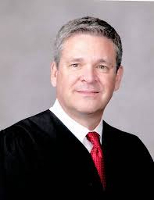
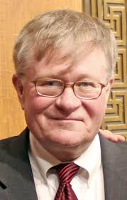
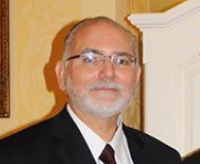
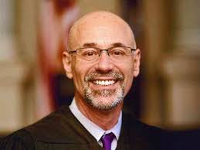
At this point then, it was clear there existed no further provision/possibility for continued action within the First Circuit Judicial Council. So proceedings in the Judicial Council venue were now at an end.
Judicial Conference Proceedings
On Mar 6 2017, as already mentioned supra, Tuvell also (in addition to his Petition for Review by the Judicial Council, supra) filed his irregular/extraordinary Emergency Objection/Motion/Proposal (together with adequate supporting materials) directly with the Judicial Conference,α′ moving that they intervene in this case (wresting control away from the First Circuit), for good and sufficient reasons.
α′・ Strictly speaking, such dealings are conducted with the so-called “Judicial Conference Committee on Judicial Conduct and Disability” (not just “Judicial Conference”), though for simplicity we continue to use this not-uncommon abuse of language (it causes no ambiguity/misunderstanding). Under “regular” circumstances (JCDR Å VI), a Judicial Council Complaint of Judicial Misconduct is not appealable by petition to the Judicial Conference, unless/until the Judicial Council has terminated its proceedings, rejecting the Complaint with a non-unanimous vote of the Council (JCDR 19(e)). But the present circumstances were not “regular.” (See also the preceding paragraph-footnote supra regarding the lack of clarity about exact rules of procedure at the Judicial Council/Conference in irregular circumstances.)
[Revelation #5′] On May 3 2017, Tuvell further submitted/filed this very website itself (http://JudicialMisconduct.US) into the record for the Judicial Conference, who (presumably) took it into consideration before reaching/rendering its decisions/opinions.
Tuvell never heard back (!) from the Judicial Conference concerning his “irregular” petition(/“appeal”) (apart from the Post Office’s notices of delivery, supra). (Even though, as noted above, Rule 2(b) authorizes the Judicial Conference to do anything it wants/needs/must do, consistent with justice and the spirit of the JCDA/JCDR.)
Later, then, after the conclusion of the First Circuit Judicial Council proceedings (rejections of Dec 5,11 2017, see supra), Tuvell re-pursued the further/final step available under the auspices of the Judicial Branch of Government: on Jan 22 2018 he filed his “regular”/official/formal (see ⌥ ⌥; as opposed to “irregular,” see supra) Petition to the Judicial Conference ⌥ (subsequently followed-up by a number of communications, mostly minor/trivial/non-substantive corrections/adjustments/amendments, such as typographical errors; though also commenting on the Complaint’s usage of the word “bullshit” ⌥ ⌥).
Fully eight weeks after filing (and confirmation of receipt according to U.S. Postal Service Certified Mail), Tuvell still hadn’t received an acknowledgement/confirmation that his Complaint had been received/filed by the AOC (Administrative Office of the Courts) or Judicial Conference (Committee on Judicial Conduct and Disability), even though it’s required by law/rule (JCDR 22(d)). So he complained about this, multiple times, and he finally did then receive a very minimal/informal(!) confirmation, which still didn’t satisfy the requirement of JCDR 22(d) (email1, email2, email3). But that still wasn’t a formal notice of receipt.
More attempted contacts followed: ⌥ ⌥ ⌥ ⌥ ⌥. Finally, some digging revealed a bit more information (including names and phone numbers) about the very secretive AOC (phone number 202-502-1500): here ⌥ and here ⌥. Finally, in April 2019(!), Tuvell was able to reach an AOC employee, Angela Garcia (direct phone number 202-502-1573; voice mailbox 301-448-5225), who was (according to her own self-description) the point-contact for people trying to learn about the status of their petitions. She explained that the Judicial Conference typically does not deign to reply/respond to petitioners (!), and in any event the Conference had rejected his petitions. Apr2a; Apr2b; Apr4a; Apr5a; Apr5b; Apr5c; Apr15a; Apr16a; May24a; May31a; May31b.
So at that point, Tuvell was forced to move on to the next/final step: criminal proceedings (see next section).β′
β′・ If an Inspector General (IG) for Federal Courts existed (which it doesn’t), then perhaps Tuvell could/would have sought their help. But even that’s not certain, if such an IG were (as currently proposed) “strictly prohibited from investigating or reviewing the merits of a judicial decision in any federal court.” ⌥ ⌥ ⌥ ⌥
Criminal Proceedings: DOJ, FBI, PIN, OPR, EOUSA, IGs, CIGIE
As mentioned supra, concomitantly with his work on Judicial Misconduct proceedings with the Judicial Council (a purely Judicial Branch in-house affair, without contemplation of civil or criminal penalties), Tuvell became aware of the potential for statutory criminal charges against the judges (noting/recalling that the precept of so-called “(absolute) judicial immunity” applies only to civil actions, not to criminal proceedings — see Introduction … But Criminal Liability). Thereupon, he tried several (~half-dozen) times to contact (by email, U.S. mail, telephone) authorities in the DOJ, FBI and PIN. All attempts were frustrated by stonewalling/incompetence in those departments. They either (i) didn’t reply/respond, or (ii) they replied(-without-responding) with “bum’s rush” blow-offs, or (iii) they (literally) pretended to “not even hear/understand” what Tuvell was saying (on the phone, after consulting sotto voce with superiors in the background).
At one point however, after Tuvell complained (Dec 12 2016) to the DOJ Office of the Inspector General (OIG), he was finally heeded (Feb 15 2017) — sort-of, that is, at least to the extent of prodding other officials. Whereupon Tuvell did receive a (more-or-less “official”?) “case number” (№DA300578449) from the DOJ Criminal Division. This was surely a mark of nontrivial/significant progress. But, it was not yet actionable — until, apparently/seemingly(?), all Judicial Branch pursuits (now reduced to just the Judicial Council/Conference) had been exhausted first — even though clear criminal acts had already indeed/obviously been committed, and there was no provision for “exhaustion of benefits/remedies” built-in to (any) criminal statutes. In other words: the cover-up continues still, even into the (presumptively incorruptible) DOJ/FBI/PIN.γ′
γ′・ The cover-up had, incidentally, already extended, from the Judicial Branch, into the Executive and Legislative Branches — local/state/federal representatives of various flavors, including Tuvell’s U.S. House/Senate representatives, even the (offices of the) President and presidential candidates. Not to mention various and sundry non-governmental self-proclaimed/advertised “(pseudo-)expert/advocates” — lawyers, law professors, investigative journalists, justice bloggers, “talking heads with big names,” …. But, to bother beating these already-dead horses even deader would at this point be too tedious/superfluous ….
[Revelation #5″] On May 3 2017, Tuvell further submitted/filed this very website itself (http://JudicialMisconduct.US) into the record for the DOJ/FBI/PIN, who (presumably) took it into consideration before reaching/rendering its decisions/opinions.
FINALLY (much later, due to all the delays imposed by the Judicial Council and Judicial Conference), after all Judicial Branch proceedings were finally exhausted (see preceding section), Tuvell submitted his FINAL CRIMINAL COMPLAINT ⌥ (to a dozen authorities/individuals/agencies) on May 15 2019. It features this page (with a clarifying after-added note, to the effect that (as explained elsewhere on this webpage, supra) Tuvell was NOT pro se initially, only after the two Smoking Guns occurred at the proceedings for District Court and initial Appeal):
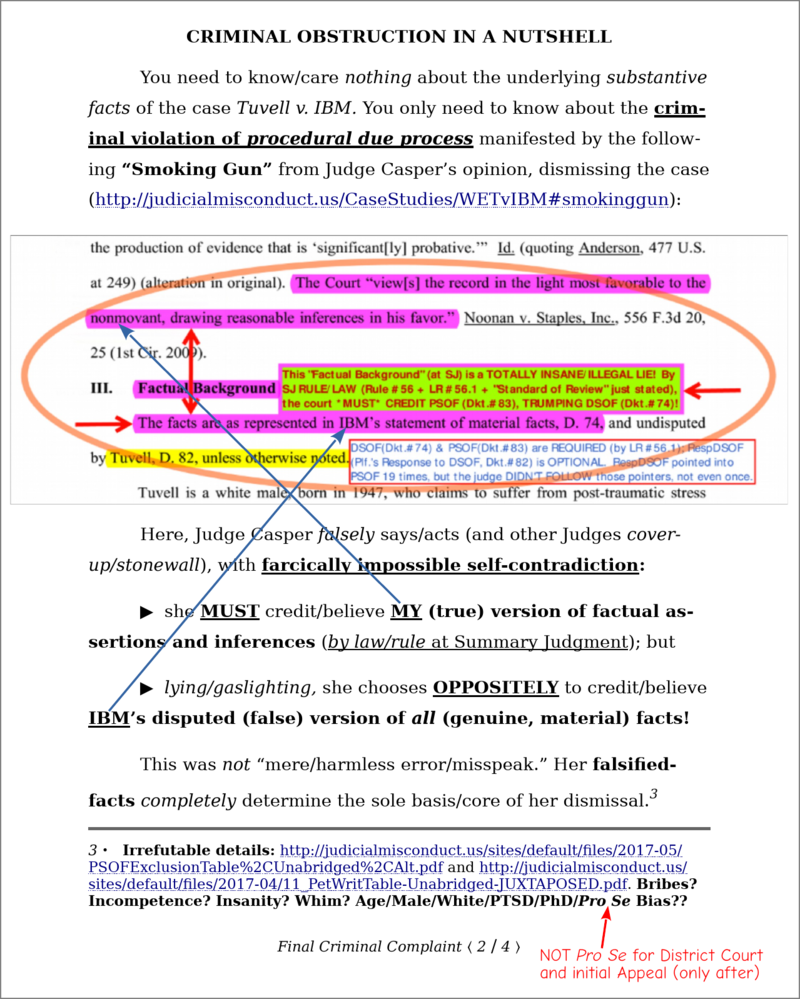
A week later (May 22), the D.Mass. U.S.A. (U.S. Attorney), Andrew Lelling, responded, falsely/criminally trying to brush me off with a blatant “gaslighting” lie (noting he’d recently tried to show he was “tough on judges” ⌥, though that was now seen to be a cynical politically motivated ploy ⌥ ⌥ ⌥ ⌥ ⌥ ⌥ ⌥). So then (Jun 5) I filed a Complaint ⌥ against him too (adding on Jun 8 an Addendum ⌥). It features this page:
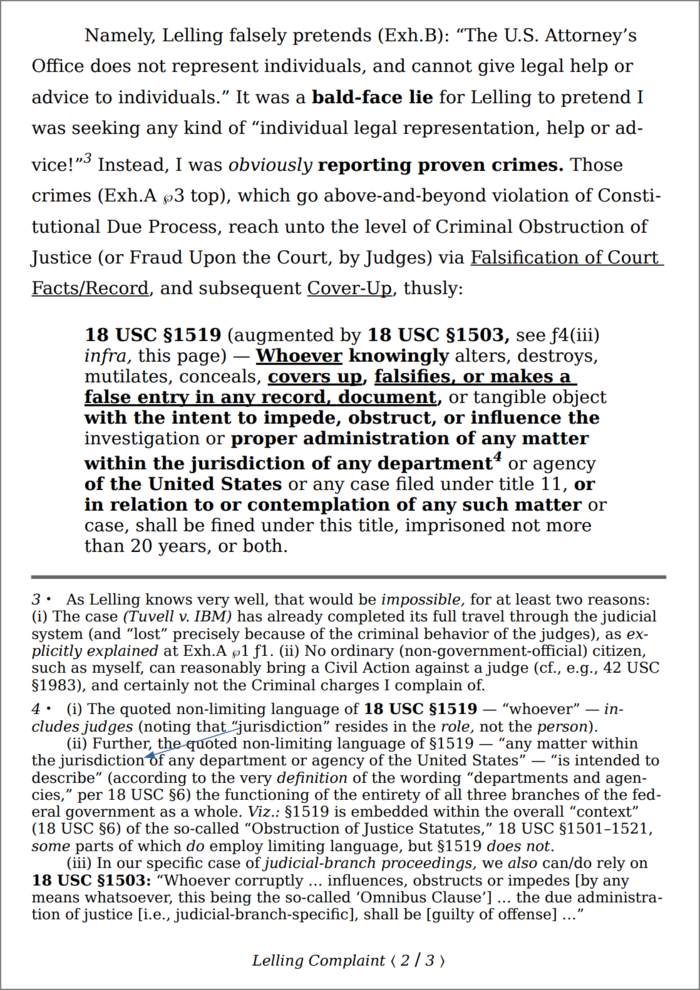
{NOTE: Upon further research, it has started to emerge that §1519 may not be as viable as originally thought (due solely to the slippery wording of §6, defining “departments and agencies”); so invocation of §1519 should now be demoted in our theories, and §1503(Omnibus Clause),1001 promoted instead, because they are certainly valid (and noting that the Omnibus Clause certainly embraces §1519’s Falsification of Facts and Cover-Up); and §371 (Conspiracy, see infra) certainly remains valid too; “lose the battle, win the war …”}
(For a semi-technical [i.e., sub-law-review] article on Obstruction of Justice, see The Law of Lying ⌥ ⌥. It contains this quote [just as you’d expect]: “There are numerous justifications for criminalizing lying: lies frustrate investigations, waste time and resources, and threaten incorrect results. But lies by government actors threaten even greater harms: they interfere with democratic self-governance by concealing relevant information from the voting public, undermine faith in institutions, and may implicate areas with informational imbalances, making uncovering lies particularly difficult.” For a technical paper on False Statements and Perjury, see the CRS Report ⌥, which is especially useful for its detailed discussion of 18 USC §1001.)
Then, another week later (Jun 13), Lelling responded with another equally insane letter; and so I responded on Jun 21 ⌥ ⌥ ⌥ to that one too. This letter directly addressed his batshit suggestion/instruction/“advice” that I pursue a private Civil Action against the judges, with legal technical proof that such a thing was impossible (because no private right/cause of action exists for the criminal activities I’m complaining of).
On Jun 14, the OIG (“Investigations Division”) “replied(-without-responding)” to me (where I’m making a distinction between improperly/non-substantively/non-responsively “replying” to my “syntactic”/physical letter, and properly/substantively “responding” to my “semantic” logical concerns/complaints, cf. evasive answer, dodging the question), telling me that my original (May 15) Final Criminal Complaint was “outside their investigative jurisdiction.” And so now, yet again, I was getting a pack of lies from yet another official government agency. For, I’d written to the OIG, not only on May 15, but had also CC’d them on the whole Lelling Complaint sequence of letters (just described), for purposes of their oversight (namely, both the OIG and the employees under its aegis could “see” that everything was happening under OIG’s watchful eye). So, what OIG was now doing was willfully turning a blind eye to the Lelling Complaint (not to mention the original Complaint about Judges, and FBI/PIN/etc.’s ignoring it), refusing to acknowledge/react to it, even though the Lelling Complaint was indeed directly within their admitted/chartered wheelhouse of “allegations of misconduct by employees of DOJ.” So, after waiting a couple of weeks (to guard against the fallacy of “letters crossing in the mail”), I responded to OIG ⌥ on Jul 5.
Then the next week, while reading a news report ⌥ about the infamous Alexander Acosta / Jeffrey Epstein affair, I learned (or was reminded) of the DOJ’s Office of Professional Responsibility (OPR) ⌥ ⌥. So on Jul 15 I wrote to OPR ⌥ ⌥ too. This letter is where I first seriously raise issues of: (i) conspiracy ⌥ ⌥ ⌥, 18 USC §371; (ii) statute of limitations ⌥ (superseding a perfunctory ƒ7 in the May 15 letter, not really adequately researched, which focused not really on “statute of limitations” properly so-called, but on the somewhat different (but related) concept of “finality” — see When is Finality Final, ℘2); and (iii) “continuing violations doctrine” ⌥. These issues, and their mutual interactions, are legalistically quite thorny (and this is not the place to hash it all out in great detail) — not least because conspiracy and its underlying substantive offense are distinct crimes, hence have distinct statutes of limitations and concepts of continuing violation — though of course the fact of conspiracy very strongly (~automatically) supports/bolsters arguments for continuing violation of the underlying substantive offense, and hence the tolling/extension of the latter’s statute of limitations; e.g., Federal Conspiracy Law ⌥ states (iii′) “conspiracy is a continuing crime, [so] its statute of limitations does not begin to run until the last overt act committed for its benefit,” and also (iii″) “[m]embers of the conspiracy are also liable for the foreseeable crimes of their fellows committed in furtherance of the common plot.” In this letter also I raise (iv) government officials’ “failure/refusal-to-act” as one (but not the only) type of element/evidence (of both conspiracy and the underlying substantive offenses, Obstruction of Justice via Falsification of Facts and Cover-Up, noting that later co-conspirators in the DOJ/FBI/PIN are certainly implicated in the Cover-Up portion). Now, in general, omission-to-act may not be considered an “overt act” liability (for conspiracy or anything else), unless there is some sort of duty/obligation/compulsion to act/perform — but that is exactly the case for government officials, because of their solemn/sworn Civil Service Oath of Office (5 USC §3331): “… I will well and faithfully discharge [not shirk] the duties of the office on which I am about to enter” (see also the DOJ Ethics Handbook ⌥, which in turn cites the Basic Obligations of Public Service for Executive Branch employees, 5 CFR §2635.101, esp. (b)5: “Employees shall put forth honest effort in the performance [not the non-performance] of their duties”). And, in the present case, there are no “mitigating circumstances” (for either conspiracy or underlying substantive offense), obviously.
WHAT THIS MEANS IS: The MOST TRUSTED ENTITIES (by their own admission/claim, and even by general/public consensus) in the U.S. Government (DOJ’s OIG, OPR, PIN [but later see also EOUSA, and especially CIGIE, infra]) are right now as of this writing (mid-Jul 2019) “working on” this case (it’s “in their laps,” as described above). They are compelled to act (as just explained) — if they don’t, then they themselves are guilty of Criminal Conspiracy to Obstruct Justice via Falsification of Facts and Cover-Up (as just explained). So this represents an irreducible acid test for the U.S. Government: does any shred of decency/integrity remain in the system? Or not⁇ We shall see …
OIG replied(-without-responding) again to me on Jul 15, referencing my Jun 5/8 letters, “passing the buck” to the Executive Office of U.S. Attorneys (EOUSA) — which sort-of seemed like it could/should be a good sign(‽), except for the very important fact that the issue being passed to EOUSA was only the minor/secondary Lelling affair, not the major/primary Judicial Misconduct affair. On Jul 23, I wrote back to OIGδ′ ⌥ (and to OPR, and to EOUSA), in which I reminded them of that primary/secondary distinction (just mentioned). On Jul 31, OIG once more replied(-without-responding) to me, again “passing the buck” to EOUSA, this time referencing my Jul 15 letter, but still ignoring the primary/secondary distinction (just mentioned). In other words, what OIG was doing was “ducking the whole thing:” (i) pretending that the minor/secondary Lelling affair was the only issue on the table; (ii) pretending that EOUSA would “handle” that (i.e., hoping/knowing they’d “spike” it somehow); and (iii) pretending that the major/primary issue of Judicial Misconduct (and FBI/PIN’s investigation of that) would just “somehow go away.” What really should happen, instead of OIG “passing the buck” anywhere, is that OIG itself should conduct a full-fledged investigation (resulting in prodding/forcing FBI/PIN to conduct a full-fledged investigation), with an official OIG report (joining all federal reports).
δ′・ In my Jul 23 letter, at ℘3ƒ4, I march through the three elements of an Obstruction of Justice crime (as delineated by a CRS Report ⌥), using 18 USC §1519 as an example (though other Obstruction Statutes, such as §1503,1001, can be used equally as well). There, I observed that its “intent” clause was proven by the fact that the judges self-admitted they knew what they were supposed/required to do (namely, credit MY facts/inferences), but they falsely/anti-legally chose to do the exact opposite instead (credit IBM’s). There may be some lingering doubt in the reader’s mind whether this “intent” deduction (which involves difficult-to-prove “state-of-mind”) — “‘intentional commission of obstructive act’ implies ‘intention to commit the ensuing obstruction’” — is correct (in the legal sense). The answer is Yes. The leading case is U.S. v. Neiswender, 590 F. 2d 1269 (4th Cir., 1979) ⌥. That case (which has been cited many times in other cases ⌥ ⌥) goes to great lengths to establish the time-honored “intent rule of natural consequences” (which 99.999+% of non-lawyer jurors/fact-finders automatically/reflexively agree with, and which we paraphrase here): “Every reasonable/rational person intends the natural/probable/likely/foreseeable consequences of his acts knowingly done/undertaken.” Or, to quote Neiswender directly: “[W]e hold that a defendant who intentionally undertakes an act or attempts to effectuate an arrangement, the reasonably foreseeable consequence of which is to obstruct justice, violates §1503 even if his hope is that the judicial machinery will not be seriously impaired.” QED.
On Aug 7, EOUSA sent me a letter, purporting to be their analysis. What a joke it was: it advised me to do three things that I had already done! (Hello, Charles Dickens, Little Dorrit, The Circumlocution Office ⌥.) So, the aforementioned potential “good sign” turned out to be a bad sign after all: here was yet another “official” government agency totally lying (not “merely” incompetent, as my response letter to them shows) about my situation. And so now, yet again, I responded ⌥, on Aug 13 (citing a Congressional smack-down of EOUSA ⌥; see also ⌥ ⌥). On Aug 20 I also wrote an email{PdfAnn} to the DOJ Criminal Division (with which I had communicated much earlier, cf. supra), hoping I might find somebody accidentally paying attention. But I didn’t (they responded, nonresponsively, on Dec 17).
Immediately thereafter, I was “noodling around” (doing some research), and discovered the Council of the Inspectors General on Integrity and Efficiency (CIGIE) Integrity Committee ⌥ (which I’d never heard of previously; see the IG Act (of 1978, as amended 2014) ⌥, the CIGIE Policies and Procedures ⌥, two CRS Reports ⌥ ⌥ ⌥ ⌥, and ⌥ ⌥; see also CIGIE’s Quality Standards for IGs (Silver Book) ⌥). The claims on their website seemed like a perfect fit for my problems with DOJ OIG, so on Aug 21 I wrote a letter ⌥ to CIGIE (with a follow-up on Aug 22), complaining about DOJ OIG itself. CIGIE responded to me on Aug 23, with what I thought was a bizarre objection (or at least highly unusual, or maybe it was just a matter of “clarifying the allegations”?), to the effect of “complaining about the DOJ OIG organization as-a-whole, as opposed to ‘covered persons’ (in CIGIE’s sense).” So I responded ⌥ to CIGIE on Aug 26 (with follow-ups on Aug 30–31, dealing especially with constructive/imputed knowledge, a.k.a. ostrich instruction ⌥, a.k.a. willful ignorance ⌥ or blindness ⌥), explaining my understanding of the “law of agency” ⌥ — namely, “Qui facit per alium facit per se” (“He who acts through another does the act himself”) — as applied to this case, hence verifying that I was indeed complaining about “covered persons” (in particular, the DOJ IG himself, Michael Horowitz). A bit later, I sent two additional complaints to CIGIE: one additional complaint ⌥ on Sep 16, and another additional complaint ⌥ on Sep 30. And on Sep 28 I wrote a letter to CIGIE informing them of an interesting/relevant case citation I’d discovered: Han Ye Lee v. Colorado Times ⌥.
On Sep 3, CIGIE responded to me, saying it was opening a “pre-investigation” (my paraphrase)! See the CIGIE Quality Standards for Investigations (QSI) ⌥.ε′ This was a very unexpected (though welcome/hoped-for) development, to say the least, given the history of this case. Of course, there still remains the question of how honest CIGIE’s work will be, but let’s not pre-judge it: after all, it is remotely possible we may have just stumbled upon the one-and-only honest/moral/ethical/competent/etc. office in the federal government. So let’s just wait and seeζ′ …
ε′・ Alas, the QSI doesn’t explicitly mention/define anything like “pre-investigation” or “preliminary inquiry,” though such a concept seems to fit into the section on “Receipt, Analysis and Disposition of Allegation(s)” in its Appendix A. Too, the Silver Book cited supra defines a so-called “Threshold Standard” that must be surmounted before the CIGIE-IC (Integrity Committee) will further review an allegation, which includes “violation of any law, rule or regulation,” or “[mis]conduct so serious that it may undermine the independence or integrity reasonably expected of an IG or OIG senior staff member,” as it should. The Silver Book also has a section on “Receiving and Reviewing Allegations,” but it’s pretty non-specific. The most comprehensive IG investigations manual I’ve discovered is the DOD IG Administrative Investigations Manual ⌥. In any event, in my mind I translated “pre-investigation” to mean something like “a phase where CIGIE only discusses the complaints/allegations internally and with the complainant, as opposed to officially notifying/interviewing the subjects of the complaints.”
ζ′・ And while we’re waiting, we can speculate on the potential role of whistleblowers in our case. Namely, we are inspired, at this very time (of our waiting/writing, Sep 18), by an extraordinary example of courage transpiring within the IG corps (or so it seems as of this writing, though the complete jury is still out because the story is still quite fresh). Namely, (it seems, provisionally, that) a whistleblower has come forward in the ODNI (Office of the Director of National Intelligence), and that the IC IG (Inspector General of the Intelligence Community), Michael Atkinson ⌥, has acted honorably/heroically by reporting the whistleblower’s allegations properly (exactly as we hope happens in our case!), only to be thwarted by the (acting) DNI ⌥! — see ⌥ ⌥ ⌥ ⌥ ⌥ ⌥. We can only hope/pray that our current position with CIGIE (and potential whistleblowers within CIGIE itself!) will reflect the courage of the brave souls within the IC IG’s office (though, that case has political/partisan overtones, while ours has none, being solely based on fundamental principles of justice and patriotism) …
On Sep 22 I wrote a letter ⌥ to OGE (Office of Government Ethics); this letter was just in the nature of an “FYI,” because OGE doesn’t really have the power/jurisdiction to actually do anything in this arena. And similarly, on Sep 23 I wrote a letter ⌥ ⌥ (via webform) to OLC (Office of Legal Counsel). Both of these were just in the nature of due diligence, making sure all bases were covered, but it still seemed like CIGIE was the best bet for a legitimate/honest/integral organization within the government (given that by that point “impeachment fever” was in full swing in Wash. D.C., threatening to swamp everyone there).
… Well, I was wrong (about “waiting and seeing” if CIGIE would be honest/integral). On Oct 9 CIGIE wrote me a dismissal letter ⌥. And on Oct 12 I responded ⌥ ⌥, explicitly telling them why their abusively “conclusory” behavior amounted to totally outrageous lying/stonewalling/gaslighting.
The Court of Public Opinion
⌘TBD⌘
Summary/Conclusion
This case is still active, at the time of this writing. But just barely, at background/ level …
So, while the final chapter cannot quite yet be written, most of the story is already/permanently extraordinarily clear. Namely: The Federal First Circuit Judges (six District Judges, plus all six Appellate Judges, all named supra), plus the Supreme Court, plus the Judicial Conference (First Circuit), plus the Judicial Conference, are fucking lying corrupt traitorous criminals, as documented supra. And further, by reasonable deduction, the (Federal) Judicial System “as-a-whole in-general” (though not necessarily “every-single-individual”) — comprising judges, attorneys, professors, lawyers, clerks, etc. — is a fucking lying corrupt traitorous criminal enterprise (in the sense documented supra). And now too, DOJ/FBI/PIN/OPR/EOUSA/CIGIE can now be added to the mix.
⌘TBD⌘
The Big Lie (Der Große Lüge)η′
η′・ “The Big Lie” idiom† was already alluded to subliminally in PetWritCert (℘24), but without the interpretive apparatus accorded to it here. {†・The “Big Lie” idiom is of course well-known, and this instance of it is independent/orthogonal of its usage in any other place (in particular, this stupid book, that’s just an accidental/inadvertent/unknowing collision). The “Big Lie” we’re talking about on this website is, of course, “known-false promises of governmental (esp. judicial) fidelity to the guarantees (esp. statutory and common laws) published/advertised to citizens/subjects.”}
… in der Größe der Lüge immer ein gewisser Faktor des Geglaubtwerdens liegt, da die breite Masse eines Volkes im tiefsten Grunde ihres Herzens leichter verdorben als bewußt und absichtlich schlecht sein wird, mithin bei der primitiven Einfalt ihres Gemütes einer großen Lüge leichter zum Opfer fällt als einer kleinen …
— Adolph Hitler, Mein Kampf ʋI Ͼ10 (1925)θ′
θ′・ Due to certain controversies ⌥ surrounding translations of Mein Kampf, we present four translations of this passage, infra.† {†・Incidentally, Hitler wrote this passage in the context of (what he considered) “Jewish ‘big lies’” — thereby himself unwittingly committing the original/prototypical “Big Lie.”}
… in the big lie there is always a certain force of credibility; because the broad masses of a nation are always more easily corrupted in the deeper strata of their emotional nature than consciously or voluntarily; and thus in the primitive simplicity of their minds they more readily fall victims to the big lie than the small lie …
… in the size of the lie there is always contained a certain factor of credibility, since the great masses of a people may be more corrupt in the bottom of their hearts than they will be consciously and intentionally bad, therefore with the primitive simplicity of their minds they will more easily fall victims to a great lie than to a small one …
— Reynal & Hitchcock ed. (1939)
… the magnitude of a lie always contains a certain factor of credibility, since the great masses of the people in the very bottom of their hearts tend to be corrupted rather than consciously and purposely evil, and that, therefore, in view of the primitive simplicity of their minds, they more easily fall victim to a big lie than to a little one …
… within a big lie, a certain fraction of it is always accepted and believed. At the bottom of their hearts, the great masses of a people are more likely to be misled by their emotions than to be consciously and deliberately bad. In the primitive simplicity of their minds, they will more easily fall victim to a large lie than a small lie …
One should not as a rule reveal one’s secrets, since one does not know if and when one may need them again. The essential English leadership secret does not depend on particular intelligence. Rather, it depends on a remarkably stupid thick-headedness. The English follow the principle that when one lies, one should lie big, and stick to it. They keep up their lies, even at the risk of looking ridiculous.
— Joseph Goebbels, Churchill’s Lie Factory (1941)ι′
ι′・ This passage of Goebbels, considered to be inspired by (or a variation/reinterpretation of) Hitler’s Mein Kampf “Big Lie” theory (just presented, supra), is more commonly seen (mis/re)-attributed in the following elaborated form ⌥ (colloquially called “Goebbels’ Big Lie Technique”): “If you tell a lie big enough and keep repeating it, people will eventually come to believe it. The lie can be maintained only for such time as the State can shield the people from the political, economic and/or military consequences of the lie. It thus becomes vitally important for the State to use all of its powers to repress dissent, for the truth is the mortal enemy of the lie, and thus by extension, the truth is the greatest enemy of the State.” Nowadays, The Big Lie is encapsulated by the more modernized “Gaslighting” meme. See also, in this connection, the JudicialTwilightZone essay, supra, and https://en.wikipedia.org/wiki/The_Twilight_Zone. And if even that’s not enough for you, in the present Judicial Misconduct context, go read Kafka’s The Trial ⌥ ⌥ ⌥; or watch its video ⌥ ⌥ ⌥ ⌥ ⌥ (which begins with Orson Welles’ recitation of Kafka’s existential parable, “Before the Law”) — all-in-all, a brilliant allegory for what’s happened to me throughout my odyssey in court-land.
